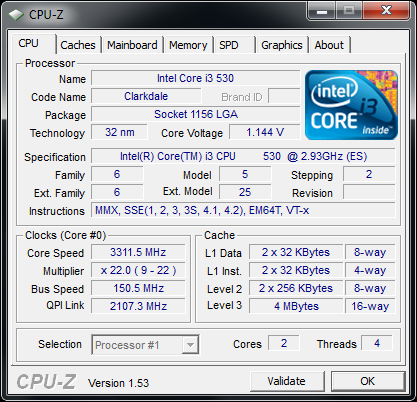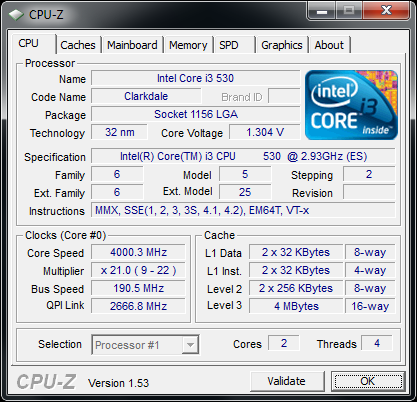The Intel Core i3 530 Review - Great for Overclockers & Gamers
by Anand Lal Shimpi on January 22, 2010 12:00 AM EST- Posted in
- CPUs
Overclocking the i3 - 4GHz with the Stock Cooler
I’ve become a fan of stock voltage overclocking over the past few years. As power consumption and efficiency has become more important, and manufacturing processes improved, how far you can push a CPU without increasing its core voltage appears to be the most efficient way to overclock. You minimize any increases in power consumption while maximizing performance. You really find out whether or not you’ve been sold a chip that’s artificially binned lower than it could have.
With Bloomfield, Intel hit a new peak for how far you can expect to push a CPU without increasing voltage. AMD followed with the Phenom II, but Lynnfield took a step back. Thanks to its on-die PCIe controller, Lynnfield needed some amount of additional voltage to overclock well. Clarkdale is somewhere in between. It lacks the crippling on-die PCIe controller, but it’s also a much higher volume part which by definition shouldn’t be as overclockable.
The Core i3 530 runs at 2.93GHz by default, with no available turbo boost. Without swapping coolers or feeding the chip any additional voltage, the most I got out of it was 3.3GHz (150MHz BCLK x 22). Hardly impressive.

I added another 0.16V to the CPU’s core voltage. That’s just under 14%. And here’s what I was able to do:

That’s 4GHz, stable using the stock heatsink/fan. Part of the trick to overclocking this thing was lowering the clock multiplier. Despite always keeping the QPI and memory frequencies in spec, lowering the clock multiplier on the chip improved stability significantly and allowed me to reach much higher frequencies.
I could push beyond 4GHz but that requires more voltage and potentially better cooling. With a stable 4GHz overclock, I was happy.
If you’ll remember from my review of the processor, my Phenom II X2 550 BE managed 3.7GHz using the stock cooler and a pound of voltage. Unfortunately it’s not enough to challenge the overclocked 530.
| CPU | x264 HD 3.03 - 2nd pass | 7-zip KB/s | Batman: AA | Dawn of War II | Dragon Age Origins | World of Warcraft |
| Intel Core i3 530 @ 4GHz | 18.4 fps | 2822 | 192 fps | 62.7 fps | 115 fps | 92 fps |
| AMD Phenom II X2 550 @ 3.7GHz | 10.4 fps | 2681 | 170 fps | 50.9 fps | 63 fps | 60.8 fps |
| AMD Phenom II X4 965 (3.4GHz) | 22.2 fps | 3143 | 196 fps | 54.3 fps | 109 fps | 74.1 fps |
Even an overclocked Athlon II X4 630 isn’t going to dramatically change things. It’ll still be faster in multithreaded applications, and still the overall slower gaming CPU.
If the Core i3 530 is right for you, overclocking is just going to make it more right.










107 Comments
View All Comments
a1623363 - Wednesday, March 24, 2010 - link
Using the same Gigabyte motherboard and same core i3, I could overclock my graphics to 900 mhz only. I pushed to 950 Mhz, but this caused errors. Serious YMMV on overclocking above 900 Mhz, especially to 1200+ !Overall, I have to say I am happy with system performance, but very disappointed in the integrated graphics. Here Intel is barely able to match performance of ATI or NVidia from years ago. I have always had an integrated graphics machine, and simply chose to play games on lower settings, but now am having to buy a Radeon HD 4770 as the performance of Intel's solution doesn't allow you to play anything made in recent years. Not to mention that games like Mass Effect 2 don't support Intel or S3 chipsets, even when Intel HD Graphics are above the minimum system requirements in terms of performance.
I am keeping my system, but if I was buying again today, knowing that the integrated graphics is sub-par, I would take a closer look at AMD plus a third party graphics card.
partha77 - Thursday, March 4, 2010 - link
Hi! As a novice in this field, i'ld like to know 3 things regarding intel core i3-530 vis-a-vis intel core 2 duo e7500 -> 1) which one delivers more performance in general? 2) which one has longer functional life span? 3) which one has more future upgradability?crochat - Tuesday, February 16, 2010 - link
It is really strange to me that all reviews I've read about intel processors with integrated graphics always tested system with discrete graphic cards. I don't play games and don't see the use of spending money on a graphic card if an IGP can deliver what I need. I suppose graphic card may have an impact not only on idle power consumption figures, but also on load power consumption figures. I wonder how i3 530 IGP compares with athlon II X4 635 with e.g. 785g.slikazn09 - Friday, January 29, 2010 - link
4ghz sounds WHOO! But what temperature does it get up to when pushed to 4ghz? You thoughtfully quoted in yourr final word, about the options set out which is pretty helpful (and i like it:] ), but what about the heat when overclocked?!slikazn09 - Friday, January 29, 2010 - link
buying options* - correcting myself from last post. any help would be greatly appreciated :). should i buy a 3rd party cooler to ensure long term stability?piasabird - Friday, January 29, 2010 - link
It seems comparing the processor to an E7500 to an I3 would be benneficial. Does the I3 really run faster than an E7500?ericore - Wednesday, January 27, 2010 - link
Hence double the speed.Simple math ladies and gents.
Bandwidth is not a factor in this case.
If you want to check it out for yourself google: intel ark
kwrzesien - Tuesday, January 26, 2010 - link
The Gigabyte GA-H57M-USB3 board has just been posted on Newegg:http://www.newegg.com/Product/Product.aspx?Item=N8...">http://www.newegg.com/Product/Product.aspx?Item=N8...
marraco - Tuesday, January 26, 2010 - link
TomsHardware had unveiled the awful 2D behavior of the most expensive nVidia and ATI card:http://www.tomshardware.com/reviews/2d-windows-gdi...">http://www.tomshardware.com/reviews/2d-windows-gdi...
They perform slower than integrated chipsets. Sometimes 10X slower.
I would like to see the same benchmarks on this integrated video
dgingeri - Monday, January 25, 2010 - link
This would make an excellent home/ small business server as well. Low idle power consumption, low price, integrated video, and virtualization all combine to make for an excellent platform for 5-10 users for file sharing, web based local apps, and minor SQL server duties.I just wonder how it compares to the new AMD chips that came out today in server performance.